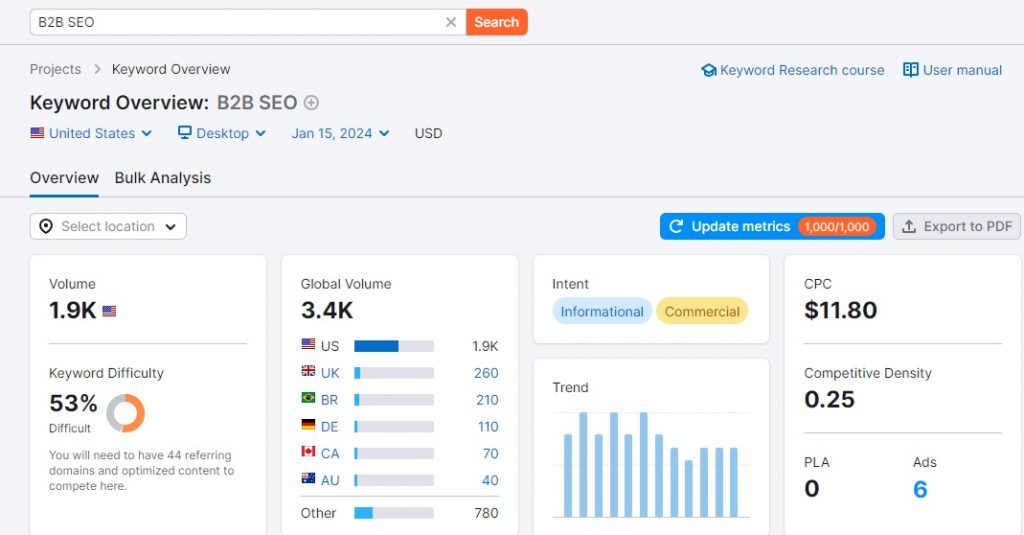
How to Create Successful B2B SEO Strategies: Tips and Advice From SEO Pros
What Is B2B SEO?
B2B SEO is a digital marketing strategy that focuses on optimizing a company’s website to improve its visibility and ranking in search engine results for relevant business-related keywords. Unlike B2C SEO, which targets individual consumers, B2B SEO aims to attract and engage other businesses as potential customers.
The goal of B2B SEO is to drive targeted organic traffic to a business website by optimizing its content, structure, and technical aspects to align with the search engine algorithms. The main focus becomes the value of organic traffic rather than its volume.
Differences Between B2B and B2C SEO

B2B SEO focuses on targeting other businesses as its primary audience, while B2C SEO aims to attract individual consumers. This difference results in contrasting approaches to keyword research, content creation, and overall marketing strategies.
In B2B SEO, keyword research tends to center on industry-specific terms and phrases that are commonly used by businesses in a particular niche. These keywords often reflect the technical aspects of the products or services being offered, as well as the specific pain points that B2B customers may face. The goal is to optimize the website and content to rank higher in search engine results for these targeted keywords and attract relevant business leads.
On the other hand, B2C SEO focuses more on consumer behavior and popular search trends. The keywords used in B2C SEO are often broader and more general, appealing to a wider audience. They may include terms related to product features, benefits, and popular consumer interests. The aim is to create content that resonates with individual consumers and drives organic traffic to the website.
From a psychological point of view, these audiences are different. The B2B audience’s main focus is on products’ features, feasibility, and ROI, while the B2C audience’s main focus is on the benefits, brand, and price of the products.
Key Challenges in B2B SEO
# Competition is very high
In B2B SEO, competition is very high compared with B2C SEO. Businesses working in the same niche try to compete fiercely with one another. So, standing in the top position in the long run is challenging.
# Conversion is very low
Conversion rates in B2B SEO are low. Generally, organizations do a lot of research and comparisons before buying a product. So someone who visits your website is unlikely to buy in one go. Businesses look for a product’s features, price, brands, and reputation in the market. Only then, when everything meets their standards, do they make a purchasing decision.
# Low-search-volume keywords
The search volume of B2B keywords is low compared with B2C keywords. However, the value of keywords is high due to potential transaction value. Even a couple of visitors to sites with low-volume keywords can yield a lot of return. The only challenge is determining the best conversion strategy to convert the maximum number of visitors into customers.
Steps to Formulate Successful SEO Strategies
-
Make a buyer persona
-
Choose your targeted keywords
-
Create a stunning blog post
-
Start blog promotion and link building
# Make a buyer persona

Source: Aweber.com
A buyer persona is a detailed profile of your ideal customer based on market research and real data. This persona helps you understand the needs, preferences, and pain points of your target audience, allowing you to tailor your SEO efforts to meet their specific requirements.
When creating a buyer persona for B2B SEO, it is important to consider various factors. Start by identifying the industry or industries that your target customers belong to. Understand the roles and responsibilities of your ideal customer, as well as the challenges they face. Consider their demographics, such as age, gender, and location. Additionally, analyze their goals and motivations when it comes to purchasing products or services in your industry.
To gather the necessary information for your buyer persona, conduct market research and analyze data from your existing customers. Reach out to them through surveys or interviews to gain insights into their buying behaviors and preferences. Use tools like Google Analytics, Google Trends, and social media analytics to understand their online behaviors, such as the keywords they use in search queries or the platforms they frequently visit.
# Choose your targeted keywords

Source: Semrush
Keywords play a pivotal role in determining the visibility and ranking of your website in search engine results. When selecting keywords, think about the search intent of your target audience. What are they looking for? What terms or phrases are they using to search for products or services in your industry?
A prudent keyword strategy can turn your website into a lead-generation machine, and the wrong strategy can sink your investment. While choosing keywords, you should decide which ones work for organic ranking and which keywords you should use to run a Google ad. Since we know that the first three places on the Google page are reserved for Google ads for every potential commercial keyword, focusing on organic ranking would be a waste of time and money. You can sort them for the long-term strategy rather than the short-term.
# Create a stunning blog post

Source: Hubspot
Creating a perfect blog page is the key to success in B2B SEO. All your efforts will be useless if you are unable to engage with visitors to your blog page. If your bounce rate increases, it will impact your ranking position too. So, while creating a blog post, carefully consider all the relevant factors like TOFU (top of the funnel), MOFU (middle of the funnel), and BOFU (bottom of the funnel) and plan your content strategy accordingly.
While creating the blog, be sure that your website has proper business branding and a digital logo because visitors want to check a site’s reputation and brand popularity before making a purchase decision.
# Start blog promotion and link building

Search engines like Google use various ranking factors, such as relevance, user experience, engagement, social media sharing, and backlinks. So, to promote your blog, you should share your post on leading social media sites like Facebook, X, and LinkedIn. On the other hand, link building focuses on acquiring high-quality backlinks from authoritative websites in related industries.
These backlinks act as votes of confidence for search engines, indicating that your website is trustworthy and relevant. The links can be built through strategies like guest blogging and requesting that the editor link to your blog where it looks relevant, requesting updates to broken links, and reaching out to industry influencers to share your valuable resources with their audience.
Tips and Advice From SEO Pros
Finally, here are some tips from SEO professionals who use these techniques to promote their B2B business sites. These tips provide strategic insight into SEO to help you get your blog to rise quickly in the search engine results.
“Analyze competitor keywords continually.” —Mark McShane, co-founder at Boiler Cover UK
Analyzing competitor keywords is the best practice to get current search trends and new potential keywords related to your industry. By monitoring the keywords that competitors are using in their online content, you can gain insights into your own strategies and identify opportunities for improvement. This process involves regularly reviewing competitor websites, blogs, and social media profiles to identify the keywords they are targeting. By understanding which keywords your competitors are ranking for, you can adjust your own keyword strategy to target similar or alternative keywords that may be more beneficial.
This ongoing analysis allows you to stay on top of industry trends and adapt your SEO strategies accordingly, ensuring you remain competitive in search engine rankings. In addition, by continually analyzing competitor keywords, you can uncover new opportunities you may have overlooked, helping you expand your reach and attract a wider audience.
“Make an email list of your industry audience.” —Michael Batalha, founder and CEO at Emercury
Building email lists is the best way to promote your B2B website. By collecting email addresses from visitors to your website or subscribers to your products or services, you can create a valuable database of contacts who have shown interest in your products or services. This lets you stay in touch with them and send them updates, promotions, and relevant information.
The benefit of having an email list is the potential for increased website traffic and lead conversion. By sending regular emails to your subscribers, you can drive them back to your website and encourage them to engage with your content. This increased traffic can signal to search engines that your website is relevant and valuable, leading to improved search rankings and resulting in more organic traffic. Moreover, sending new offers and promotional emails to subscribers will increase the chances of converting them into customers of your newly offered products and services.
For making an email list, you can use an email pop-up on your website or encourage visitors to subscribe to newsletters by giving them freebies like ebooks, software downloads, or other products or content related to your industry.
“Continually check and remove toxic and spammy backlinks.” —James Lee, founder at Monetized Future
Backlinks are still a significant ranking signal on Google, but what matters is their quality. Getting links from authoritative sites improves your website’s authority and ranking position, while backlinks from toxic (gambling, porn, and CBD) and spammy sites impact your authority and sometimes attract manual penalties from Google.
So you should continually check your backlinks profile, and if there are some spammy and toxic backlinks, remove them. You should use Google’s disavow tools to remove toxic and spammy backlinks to eliminate their impact on your ranking factors.
“Try to embed relevant video inside your blog.” —Peter McDouglas, co-founder at HaroLink Building
Embedding relevant videos supporting your blog’s content can be a highly effective strategy for improving your website’s SEO. Video content is becoming increasingly popular, and search engines like Google are placing more emphasis on videos in their search results. Even though video doesn’t directly affect your blog’s ranking, it can help a lot indirectly, improving UX (user experience), increasing engagement, and converting users into leads.
When embedding video into your blog, don’t host the video on your website server, as it may reduce your website loading time, which will hurt your SEO significantly. Rather, create an official channel for your company on YouTube or other video hosting sites and then embed the video inside your blog, which ultimately increases your UX without affecting your website’s speed.
“Use Google Ads Quality Score to improve your organic page.” —Vidyarthi Ram, SEO Consultant at Rank Care
Google Ads Quality Score is a tool in Google Ads for measuring and improving an ad’s performance. It uses a 1 to 10 scale, and the higher your landing page Quality Score, the higher the chances your ad will perform, depending on other factors. Top SEOs use this tool to improve the organic page for ranking purposes. The common understanding is that the page matrices that are the best for ad performance would surely be better for organic search.
The ad Quality Score focuses on three main elements: 1) expected through rate, 2) ad relevance, and 3) landing page experience, which are also included in Google’s algorithm for organic search, like page relevance, topic relevance, and user experience (UX). So you can use this tool to analyze your page performance, and if there is a suggestion for improvement, try to update accordingly.
“Technical SEO should be updated and corrected timely.” —Liam Quirk, Managing Director at Quirky Digital
Technical SEO is compulsory to prepare your website for listing in the SERP index. For performing well on search engines, it must be updated and corrected according to the latest SEO practice; otherwise, it will lose the chance to rank even if you have the best landing page and backlinks. Here are some key areas that should be regularly corrected and updated for better performance:
- Site speed
- Crawl errors and broken links
- XML sitemap
- Robots.txt file
- Canonicalization
- Structured data markup
- SSL certificate
All of the above should be updated in a timely manner, and if there are any errors, try to correct them immediately to avoid getting penalized by Google.
“Use social media to promote your website.” —Bobin D’Silva, founder at SAASTalkies
Social media has become a significant way to promote products and services online and drive traffic to a website. Search engines also factor in social media signals for ranking and page listing. Websites that share their published content on social media like Facebook and X get indexed by Google faster than websites that don’t do this.
Moreover, Facebook ranks third after Google and YouTube for the most active users, so promoting your website on it would be a prudent way to drive already engaged users to your content. For promoting your content and products on Facebook, you can make a company page or private Facebook group. Creating a Facebook group is the best way to gather potential audiences related to your industry. But Facebook groups don’t grow automatically; you need to know about Facebook group invites and promotion strategies to grow these communities faster. Then you’ll want to continually post engaging content and posts related to your industry to encourage group members to stay active.
Final Thoughts
Following all the strategies suggested here, you can make your B2B SEO successful and outperform your competition. Because the digital space is dynamic, you must stay abreast of current news and updates in the market so that you can incorporate the latest technological changes into your website to make your B2B SEO successful in the long run.



